| PaintPRO Archives — Painting Tips |

Masking and other trim
in Surface Prep
Masking baseboard and other trim in preparation for painting walls and ceilings is essential. It doesnt matter how good a roller sleeve you have or how good a painter you are. Splattering will occur, and small edges like the top of the baseboard will be the spots that get hit first.
It is always frustrating to see that your wall paint has leaked under the masking tape, leaving a messy edge when the tape gets pulled. While many masking tape manufacturers now offer better quality products that minimize paint seepage, it’s still a good idea to consider the potential for problems.
 One important way to help avoid problems with paint seeping under the tape is to change the angle of your brush when you’re “cutting in.” On baseboard, because it is down low, we often paint in a downward direction (as shown in photo 1), thus forcing paint under the edge of the tape should weaknesses with the masking exist. To minimize this problem, simply change the angle of the brush so it has a more perpendicular approach to the wall (as shown in photo 2). Changing the angle of your brush may require you to reach lower or crawl along the baseboard while you’re cutting in, but it will save you considerable anguish and leave a much cleaner line when your masking tape gets pulled. One important way to help avoid problems with paint seeping under the tape is to change the angle of your brush when you’re “cutting in.” On baseboard, because it is down low, we often paint in a downward direction (as shown in photo 1), thus forcing paint under the edge of the tape should weaknesses with the masking exist. To minimize this problem, simply change the angle of the brush so it has a more perpendicular approach to the wall (as shown in photo 2). Changing the angle of your brush may require you to reach lower or crawl along the baseboard while you’re cutting in, but it will save you considerable anguish and leave a much cleaner line when your masking tape gets pulled.
— Bent Mikkelsen
PaintPRO magazine
|

